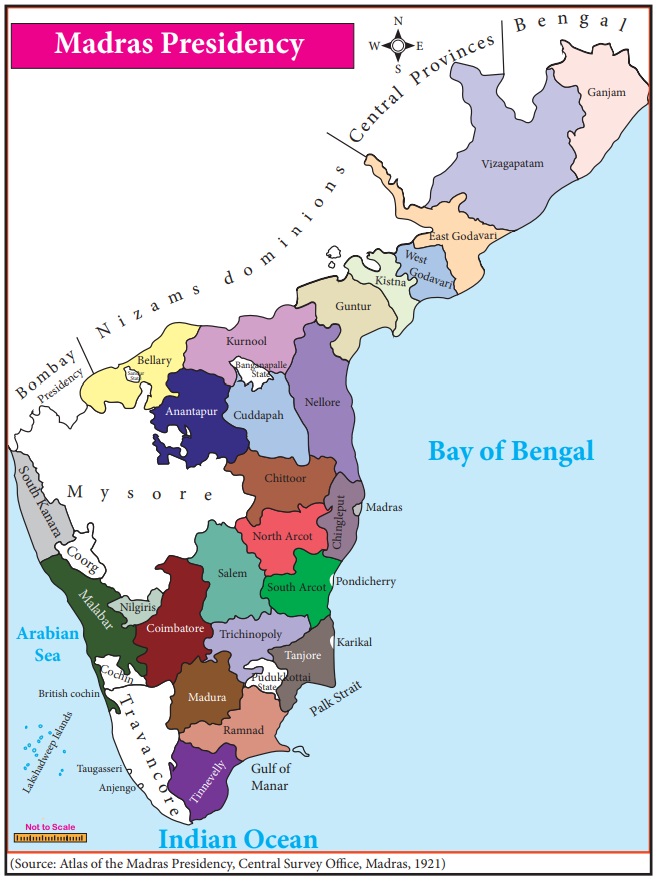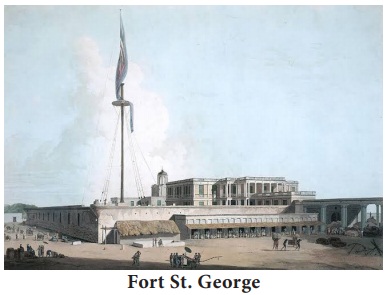Urban changes during the British period | Chapter 7 | History | 8th Social Science - Origin and Growth of Madras | 8th Social Science : History : Chapter 7 : Urban changes during the British period
Chapter: 8th Social Science : History : Chapter 7 : Urban changes during the British period
Origin and Growth of Madras
Origin and Growth of Madras
The beginning of the city of Madras goes back to the earliest stages of British commercial enterprise in India. The English East India Company was started in 1600 A.D(C.E). Twelve years later, a Factory was set up at Surat on the West coast. Subsequently the search for textiles brought British merchants to have port on the east coast.

Presently Fort St. George is the power centre of Tamil Nadu State Government, extending across 172 sq. KM (66 sq. miles)
The English, after some efforts secured the privilege of building a factory at Masulipatnam. It was well protected from the monsoon winds. But then Masulipatnam was in the throes of a famine. In spite of every assurance of protection, English trade did not thrive at that place.
Then the English traders looked for a new site. Francis Day, the member of the Masulipatnam council and the chief of the Armagon Factory, made a voyage of exploration in 1637 with a view to choose a site for a new settlement. At last, he was given the offer to choose Madrasapatnam. Francis Day inspected the place and found it favourable to set up factory.
The official grant for the land was given by Damarla Venkatapathy Nayak, the deputy of the Raja of Chandragiri (12km west of Tirupathi). Damarla gave British a piece of land between Cooum river and the Egmore. In 1639 the deed was signed by English East India Company’s Francis Day accompanied by his interpreter Beri Thimmappa and superior Andrew Cogan. By this Francis Day and Andrew Cogan (the chief of the Masulipatnam Factory), was granted permission to establish a factory – cum - trading post and a fort at Madrasapatnam in 1639. This fortified settlement came to be known as Fort St. George settlement. It is otherwise referred to as the White Town. While the nearby villages inhabited by local population was called as Black Town. Collectively the White Town and the Black Town were called Madras.

Madrasapatnam
Damarla Venkatapathy gave the English the grant of Madrasapatnam. He was under the control of Venkatapathy Rayalu, the Rajah of Chandragiri. Venkatapathy was succeeded by Srirangarayalu in 1642. He issued a new grant to English in 1645 called Srirangarayapatnam. Venkatapathy desired that the name Chennapatnam should be given to the new Fort and settlement of the English after his father Chennappa Nayak. But the English preferred to call the two united towns by the name of Madrasapatnam.
Making of Chennai
Chennai was once a group of villages set amidst palm fringed paddy fields until two English East India Company merchants visited there. Raja Mahal in Chandragiri palace, where Sir Francis Day of the East India Company was granted land in 1639 in order to set up factory which later came to be known as Madras. This first factory was completed on St. George’s Day, 23 April 1640 and named Fort St. George. Day and Cogan were jointly responsible for the construction of Fort St. George. This was the East India Company’s principal settlement until 1774.
The first building to be seen on entering the Fort through the Sea Gate is the seat of the Government of Tamil Nadu. These impressive buildings built between 1694 and 1732 are said to be among the oldest surviving British Construction in India.
The Madras presidency was an administrative sub division which was referred to as the Madras province. The Madras presidency during the British regime covered a vast exopause of the southern part of India that encompasses modern day Tamil Nadu, the Lakshadweep Island, Northern Kerala, Rayalaseema, coastal Andhra, districts of Karnataka and various districts of southern Odisha.
Dalhousie Square in Calcutta and Fort St. George in Madras were close to the central commercial area and had massive buildings which were British variants of Roman styles.
After independence in 1947 the Madras presidency became the state of Madras and the other regions that were a part of the erstwhile presidency were constituted in separate states of Andhra Pradesh, Kerala and Mysore under the States Reorganisation Act, 1956. Later on in 1969 the State of Madras was rechristened as Tamil Nadu. On 17th July 1996, Madras was officially renamed as Chennai.
Related Topics